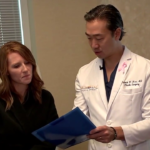Understanding Your Flap Options for Breast Reconstruction After Mastectomy

Finding out that you have breast cancer is understandably devastating news. Perhaps the only thing even more unbearable is learning that mastectomy surgery is required to treat cancer. Whether it be surgery to remove one or both breasts, some women feel that the surrounding loss can be almost as overwhelming as the cancer diagnosis itself.
While it is true that there is currently no procedure that can restore feeling in the breast region post-mastectomy, some recent advances have expanded the range of reconstruction options available.
With flap surgery, patients can have excellent cosmetic results whether through the use of implants or using their own tissue. After battling breast cancer, many women now have the choice of reconstructive surgery to look and feel like themselves again.
Even as breast implants remain a safe and popular choice, a more natural and longer-lasting option has emerged in the form of free-flap reconstruction at advanced breast centers like Memorial Plastic Surgery.
What is Flap Surgery?
Also called autologous reconstruction or autogenous reconstruction, flap surgery uses tissue from another place on your body to form a breast shape. This tissue (called a flap) can include skin, fat, and sometimes, muscle.
That flap usually comes from the belly, the back, the buttocks, or the inner thighs to create the reconstructed breast. Because it can be completely separated from its original blood vessels, picked up, and move to its new spot on your chest, it is referred to as a “free flap.”
That same tissue can also remain attached to its original blood vessels and moved under your skin to your chest instead, where it is then referred to as a “pedicled flap.” Both types find the tissue formed into the shape of a breast and then stitched into place.
Why Do Women Choose Flap Surgery?
Because the tissue flaps look, feel, and act more like natural tissue than breast implants, women often choose the flap surgery option. Tissue flaps will change like any other tissue in your body, something implants will not do.
They may get bigger or smaller as you gain or lose weight. If an implant ruptures or something else untoward occurs, breast implants need to be replaced. There is no such concern with tissue flaps. Instead, tissue flaps are often used by themselves to reconstruct the breast although some tissue flap procedures can be used with a breast implant should more volume be required.
What Are The Breast Reconstruction Surgery Options Available?
Memorial Plastic Surgery offers several flap options for breast reconstruction. They are:
-
DIEP Flap
Deep Inferior Epigastric Perforator (DIEP) Flap uses tissue, skin, and blood vessels from the lower abdomen to restore breasts. No muscle or supportive tissue is removed from the area.
-
TRAM Flap
Breast tissue harvested from the lower abdomen and away from the abdominal muscle is the pedicle type of flap reconstruction used in Transverse Rectus Abdominis Muscle (TRAM) Flap procedures. This is best suited for patients who want larger breasts because the donor site has more fat tissue.
-
SGAP Flap
Patients who want to contour their bodies while reducing love handles often opt for Superior Gluteal Artery Perforator (SGAP) Flap surgery. The breasts are constructed using tissue harvested from the hips and upper buttocks after mastectomy.
-
IGAP Flap
For women who don’t have enough tissue in the abdomen and hips to transfer, there is the Inferior Gluteal Artery Perforator (IGAP) Flap option. A combination of fat grafting and microsurgery is used to harvest blood vessels, skin, and fat from the lower buttocks.
-
TUG Flap
Transverse Upper Gracilis (TUG) Flap surgery is something women with naturally small breasts and insufficient enough tissue in the hips and buttocks for transfer can opt for. Tissue is harvested between the groin crease and upper inner thigh to recreate the breasts with this procedure.
-
PAP Flap
The profunda artery from the back of the posterior thighs is the source of tissue to restore the breast mound with this option. Microsurgery is done to reattach the blood vessels.
Can The Nipples Be Reconstructed As Well?
While the breasts are often the subject of reconstruction, nipple-sparing mastectomy actually leaves the nipple and areola in place. By definition, the areola is the dark skin surrounding the nipple and, if necessary, providers can create a new nipple by transferring skin via skin graft from one part of your body or local skin on the breast to craft a nipple.
On the other hand, some people opt for a 3D tattoo of an areola after nipple construction. Certain specially trained tattoo artists create realistic images of an areola for that purpose.
When Should You Have Breast Reconstruction?
Two types of breast reconstruction surgery are available. Immediate reconstruction commences or begins at the time of the mastectomy. Delayed reconstruction is done after the mastectomy incisions have healed and breast cancer therapy has been completed. This can occur months or even years after the mastectomy.
Based on what you want to do, your medical conditions, and your cancer treatment, you can determine the timing for your breast reconstruction. People who have started chemotherapy or radiation treatments usually put off reconstruction until the end of their treatments. You can consult with your surgeon to help decide the ideal timing for your specific case.
What Is The Best Option For Me?
Factors such as your age, overall health, and lifestyle can help you determine what type of breast reconstruction surgery to get. Other determining factors include the kind of mastectomy or lumpectomy you had and how much tissue remains, whether you need additional chemotherapy or radiation therapy for breast cancer, past surgeries you’ve had, and your goals and desired appearance.
Make sure to take all of these things into consideration and schedule a consultation with Memorial Plastic Surgery today to make a truly informed decision.
*This blog is created and maintained for informational purposes only. The images present may not accurately reflect actual cases per individual. Individual cases are unique, and the descriptions and solutions will vary per patient.



